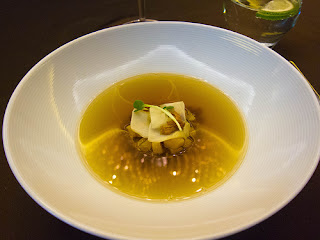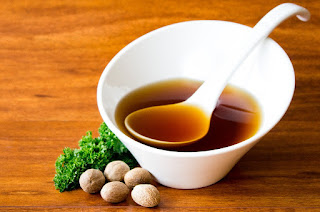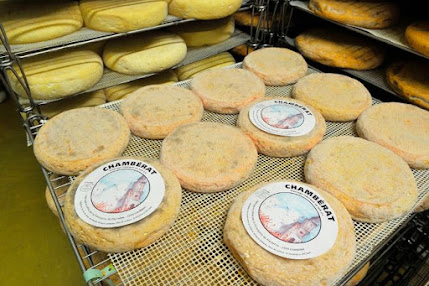from
Behind the French Menu
by
Bryan G. Newman
behindthefrenchmenu@gmail.com
A chanterelle mushroom consommé
with braised abalone, and pumpkin confit.
www.flickr.com/photos/warrenintheweeds/9709481712/
A consommé is a clear soup made from veal, beef, poultry, fish, seafood or vegetables; it will have been strained and entirely free of any bits and pieces; even the tiniest pieces will have been removed. A consommé may be served hot, cold or jelled. To really enjoy a consommé do not order one when you are hungry or when you have been tasting a strongly flavored dish beforehand. Order a consommé at the beginning of the meal, before an hors d’œuvre or entrée; then you may enjoy the pristine taste.
www.flickr.com/photos/silvershaina/16070759300/
Behind many of the great sauces and soups that you will find on French menus are variations of the consommés that may also be on your menu.
Consommés on French Menus:
Consommé Célestine - A vegetable consommé garnished with thin slices of a plain crepe. The name Célestine comes from a natural crystal, and is used as the name for many dishes in French cuisine, though most have no relation one to the other.
Consommé de Bœuf et ses Quenelles à la Moelle - Beef consommé served with quenelles flavored with beef bone marrow. The quennels in this menu listing will be meatballs mixed with a pate chou pastry dough so that they will not be all meat. The dough makes the meatballs lighter and able to portray the flavor that the bone marrow brings. The original quennels were only made with pike, the fish; but, they became so popular that versions are now made with meat. poultry, other fish, and vegetables.
Chicken consommé with vegetable quennels.
www.flickr.com/photos/16989146@N06/4509580916/
Consommé de Canard au Poivre Timut - A duck consommé flavored with Timut pepper. Timut is a Nepalese pepper, similar to Szechuan pepper but with a grapefruit tang.
Consommé de Langoustine – A consommé made with the shells of Dublin Bay prawns.
Consommé de Poule au Cerfeuil et Aromates – A chicken consommé flavored with chervil the herb, along with other herbs. A poule is an older chicken that is no longer is laying any eggs; they find new careers as boiling fowls. These older chickens have a great deal of flavor in their bones and are perfect for consommés and other soups where chicken plays an important part.
Consommé with a meringue of quail eggs,
apple, black and white truffles, pasta and spinach
www.flickr.com/photos/cyclonebill/4253975987/
Consommé de Volaille et Brunoise de Légumes Racine – A chicken consommé served with brunoise cuts of root vegetables. The root vegetables used in French cuisine include turnips, (navets) parsnips (panais) and Swedes (chou-navets or rutabaga). French culinary tradition encourages the chef to show how a dish is prepared and served and the French Brunoise cut for vegetables is tiny squares about 2mm x 2mm x 2mm (1/16’ x 1/16” x 1/16”).
Ravioles au Foie Gras, Consommé de Bœuf – Ravioli filled with fattened duck liver served in a beef Consomme.
Double consommés.
A consommé double, a double consommé; this is still a clear soup but has a rich, sometimes booming taste. Double consommés are the secret behind the preparation of many soups and sauces where they provide the underlying flavor.
Double Consommés on French Menus:
Consommé Double de Bœuf aux Xeres – A double beef consommé flavored with sherry.
Double Consomme
Consommé Double de Homard – A double lobster consommé. This consommé is made with the shell of the two-clawed European lobster, a very close cousin of the North American or Maine lobster. It is the lobster’s shell alone that will be providing the taste, much like the bones used in meat or chicken consommés.
Cold and jelled consommés.
Consommés may also be served cold, and they will be on menus as a consommé froid, a chilled consommé, or as consommé glacé, a jelled consommé, both are beautiful in the summer; smooth and refreshing.
Cold, chilled and jelled consommés on French menus:
Consommé de Boeuf en Gelée – A cold jelled beef consommé.
Chilled tomato consomme.
Consommé Froid à la Chair de Tourteaux – A cold consommé made from the meat of the edible brown crab. This crab is the most popular in France and in season will be on nearly all seafood restaurant menus.
Consommé Froid de Crevettes Grises – A cold consommé made from one of the tastiest of all shrimps, the sand shrimp.
A consommés lié.
Consommé’s that are turned into velvety soups by the addition of cream and egg yolks added just before serving may be offered as veloutes, a separate group of soups, or as a consommé lié.
A consomme lie on a French menu:
Consommé Lié de Boeuf – A velvety, creamy, beef consommé.
Connected Posts:
Searching for the meaning of words, names or phrases
on
French menus?
Just add the word, words, or phrase that you are searching for to the words "Behind the French Menu" and search with Google. Behind the French Menu’s links include hundreds of words, names, and phrases that are seen on French menus. There are over 470 posts that include over 4,000 French dishes with English translations and explanations.











